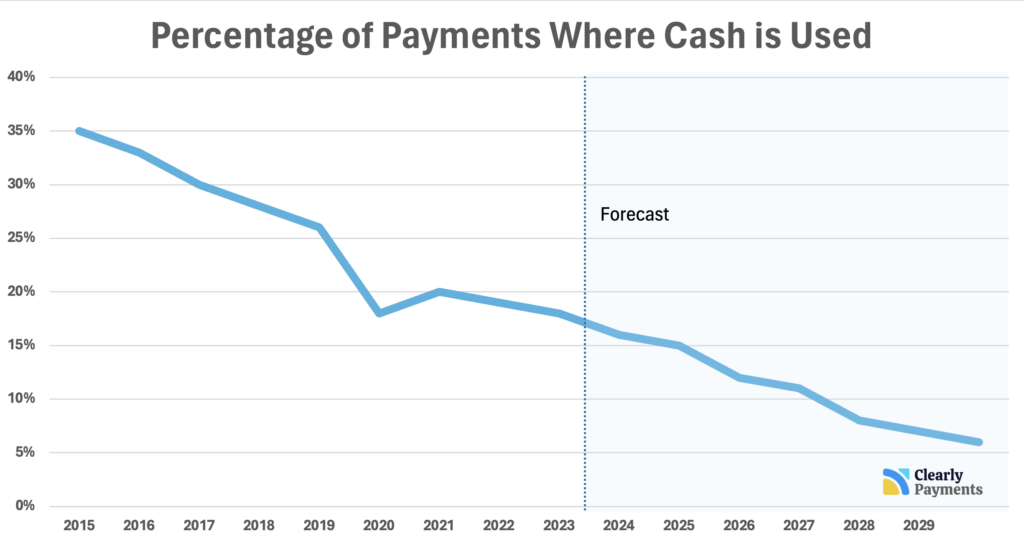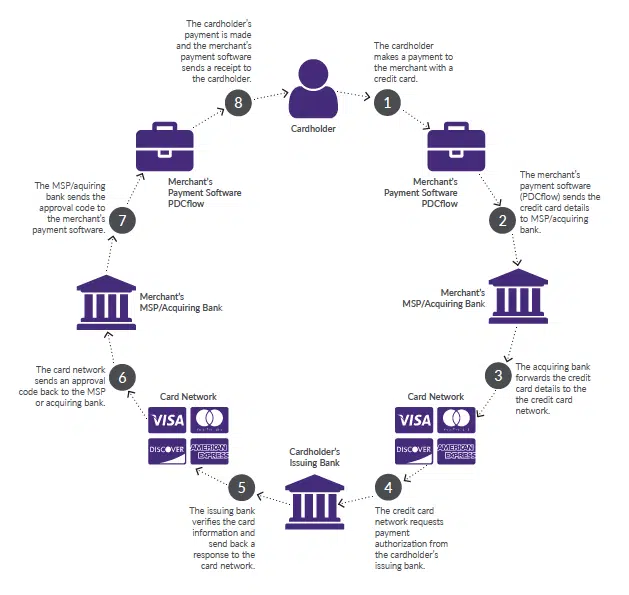
The world is going cashless, and credit card processing is at the heart of this digital revolution. If you ever thought of starting a credit card processing company, it can be a great way to make money. But it’s not the easiest thing to do!
In this blog post, we’ll guide you through the essential steps to take your dream from idea to reality. We’ll talk about the basics of credit card processing, give you a step-by-step guide to starting your own company, and show you how much it costs to get going. We’ll even explore some alternatives you might want to consider.
Table of Contents
Why You Need to Start a Credit Card Processing Company (with Statistical Proof)
Everyone loves to use a virtual credit cards and cashless payment for their purchases and that’s why there are approximately 4000 credit card issuers in the United States. Most of the people have multiple credit cards in their daily use. According to Clearly Payments, there will be only 16% cash users which will reduce to 6% in 2030.

[Image Source: clearlypayments.com]
According to the Federal Reserve (government agency):
- In North America, most young adults (around 7 out of 10) get a credit card by age 25. It’s the most common way for young people to start building credit. By 2023, about 8 out of 10 adults in North America had a credit card.
- Around the world, more and more people are using credit cards. In 2023, there were about 1.25 billion credit card holders, which is up from 1.1 billion in 2018. In the United States, there are about 166 million credit card holders, and in Canada, there are about 36 million.
- Credit card use is growing in both Canada and the USA. In Canada, many people (around 70%) use credit cards for everyday things like groceries and bills over the past year. This might be because it’s convenient, but it could also be because prices are going up (inflation) and people need credit to afford things they used to be able to buy with cash. The same thing is happening in the US. People are frequently traveling and they need to use credit cards to buy what they need.
The above statistics show that the selling credit card industry is booming! With more and more people using cards, there’s a huge demand for secure and efficient ways to process those transactions.
 Here’s why it’s a good time to start a credit card processing company:
Here’s why it’s a good time to start a credit card processing company:
- Growing Market: The number of credit card users is on the rise, especially among young adults. This creates a prime opportunity to offer your services to a large and growing customer base.
- Essential Service: Credit card processing is no longer a luxury – it’s a necessity for businesses to keep up with customer preferences. Your company can be the key that unlocking their success in the cashless world.
- Room for Innovation: While there are many processors out there, the market is constantly evolving. You can bring fresh ideas and exceptional customer service to stand out from the crowd.
Sure, there’s competition, but the continuous growth in credit cards usage shows there’s plenty of room for new players who can provide innovative solutions and exceptional service.
How Does Credit Card Processing Work (Basics)?
Credit card processing is the secure exchange of information and transfer of funds when you use your credit card. Here’s a complete breakdown from basics to advance:
Related: Can a Credit Card Company Place a Lien on Your House?
Here’s a simpler way to think about it:
- You enter your credit card information on the website.
- That info is sent to a special service called a payment processor.
- The processor checks with your bank (the one that issued your credit card) to make sure you have enough money and everything is okay.
- The processor sends a message back to the website letting them know if the payment is approved.
- If it’s approved, you get your stuff and the seller gets their money (minus a small fee).
- The credit card processor acts like a middleman between you and the store, making sure everything is safe and secure.

[Image Source: pdcflow.com]
Technical Overview
This is a simplified overview. The technical aspects involve complex communication protocols, network security measures, and fraud detection systems:
The Key Players:
There are six major key players in the whole process:
- Merchant: The business accepting your credit card payment.
- Payment Gateway: Secure software that captures your card details on the merchant’s website.
- Payment Processor: The intermediary that routes transaction data and handles authorization.
- Card Network: (e.g., Visa, Mastercard) Provides the infrastructure and sets rules for transactions.
- Issuing Bank: The bank that issued your credit card and holds your account.
- Acquiring Bank: The bank that handles the merchant’s account and receives payment settlements.
The Work Flow:
Authorization:
- You enter your card details on the merchant’s website.
- The payment gateway safely sends your information to the payment processor.
- Then, the processor forwards this information (encrypted!) to the card network.
- The network routes it to your issuing bank for authorization.
- The issuing bank verifies your card details, available funds, and potential fraud.
- An approval or decline message is sent back through the network and processor.
- The payment gateway informs the merchant’s website of the authorization status.
Settlement and Funding:
- Once authorized transactions accumulate, the merchant submits a batch for settlement.
- The processor sends the batch to the card networks.
- Networks debit the issuing banks for authorized transaction amounts.
- Issuing banks deduct the authorized amounts from cardholder accounts.
- Networks then transfer funds (minus interchange fees) to the acquiring bank.
- The acquiring bank deposits the funds into the merchant’s account (minus merchant fees).
Security:
- Encryption safeguards data throughout the process.
- Card verification codes (CVV) and Address Verification Service (AVS) help prevent fraud.
- Payment Card Industry Data Security Standard (PCI DSS) ensures secure data storage and handling.
How to Start a Credit Card Processing Company in the United States: A Step-by-Step Guide
Starting a credit card processing company in the United States involves several key steps. Here’s a simple guide to help you understand the whole process:
Research the Industry
Before getting started, you should first learn about the credit card processing industry. This includes understanding the major players, the services offered, and the regulatory environment. Key points include:
- Market Size: The global payment processing solutions market was valued at around $104.73 billion in 2023 and is expected to expand 121.77 billion in 2024.
- Regulations: Familiarize yourself with laws such as the Payment Card Industry Data Security Standard (PCI DSS) and the Electronic Funds Transfer Act.
Develop a Business Plan
A solid business plan will guide your company’s growth and operations. Your plan should include:
- Executive Summary: Overview of your business.
- Market Analysis: Thorough research on your target market and competition.
- Services Offered: Types of processing services (e.g., point-of-sale, online payments, mobile payments).
- Financial Projections: Revenue, expenses, and profit forecasts.
- Marketing Strategy: How you plan to attract customers.
Register Your Business
Choose a business name and register it with the appropriate state authorities. You’ll need to:
- Select a Business Structure: Options include sole proprietorship, partnership, LLC, or corporation. Each has its pros and cons regarding taxes and liability. Consult a lawyer for the best fit.
- Obtain an Employer Identification Number (EIN): Required for tax purposes and can be obtained from the IRS.
Secure Funding
Starting a credit card processing company requires significant capital. You may need funds for:
- Technology: Payment gateways, software, and hardware.
- Licensing Fees: Costs associated with acquiring necessary licenses.
- Operational Costs: Salaries, marketing, and office space.
Additional options may include bank loans, venture capital, or personal savings.
Obtain Licenses and Certifications
You’ll need to ensure your business complies with all relevant regulations:
- Payment Facilitator (PayFac) Registration: Required to process payments independently.
- PCI DSS Compliance: Ensures your company meets security standards for handling cardholder data.
Establish Partnerships
Partnering with banks and payment networks is essential. You’ll need to:
- Secure a Sponsor Bank: Necessary for processing transactions.
- Partner with Payment Gateways: To facilitate transactions between merchants and banks.
Setup Your Technology Infrastructure
Invest in reliable payment processing technology, including:
- Payment Gateways: Securely transmit transaction data.
- Point-of-Sale (POS) Systems: For in-person transactions.
- Online Payment Solutions: For e-commerce businesses.
Hire and Train Staff
Your team is essential to your company’s success. Key roles include:
- Sales Representatives: To attract and retain merchants.
- Customer Support: To assist merchants with issues.
- IT Specialists: To maintain and secure your technology.
Launch and Market Your Business
Once everything is set up, launch your business and start marketing. The best strategies include:
- Online Marketing: start search engine optimization (SEO) of your official website, market on social media, and begin email campaigns.
- Networking: Attend industry events and trade shows.
- Direct Sales: Reach out to potential clients directly.
Monitor and Optimize
After launching your credit card processing company, you need to continuously monitor your operations and financials. You can use metrics like:
- Transaction Volume: Number of transactions processed.
- Revenue: Earnings from transaction fees.
- Customer Satisfaction: Feedback from merchants.
You need to regularly review and optimize your processes to ensure positive growth and profitability.
Conclusion
In short, if you’re looking to start a business in a growing market, credit card processing could be a good option. But it’s important to do your research first. There are many steps involved, like getting licenses and finding partners. You’ll also need to invest in technology and staff. If you can handle the challenges, this could be a profitable venture.
FAQs: How to Start a Credit Card Processing Company? Step By Step
What is a credit card processing company?
A credit card processing company facilitates electronic transactions for businesses, allowing them to accept credit and debit card payments from customers.
What are the basic requirements to start a credit card processing company?
Basic requirements include obtaining necessary licenses and permits, establishing partnerships with banks or financial institutions, acquiring payment processing equipment or software, and implementing security measures to protect sensitive financial information.
How do I obtain the necessary licenses and permits?
The specific licenses and permits required vary depending on your location and the services you intend to offer. Research the regulatory requirements in your jurisdiction and consult with legal experts to ensure compliance.
What equipment or software do I need to process credit card payments?
You’ll need payment processing hardware or software capable of securely handling transactions. This may include point-of-sale (POS) systems, card readers, payment gateways, and merchant account services.






